Hazard and Risk of Dementia Patients in Residential Care
VerifiedAdded on 2023/06/11
|10
|2001
|282
AI Summary
This article discusses the hazards and risks associated with dementia patients in residential care. It covers safety issues and legislation, safety aids, and communication of health and safety information. The article also provides information on the optimal living environment for dementia patients and the safety aids that should be present in every residential care facility.
Contribute Materials
Your contribution can guide someone’s learning journey. Share your
documents today.
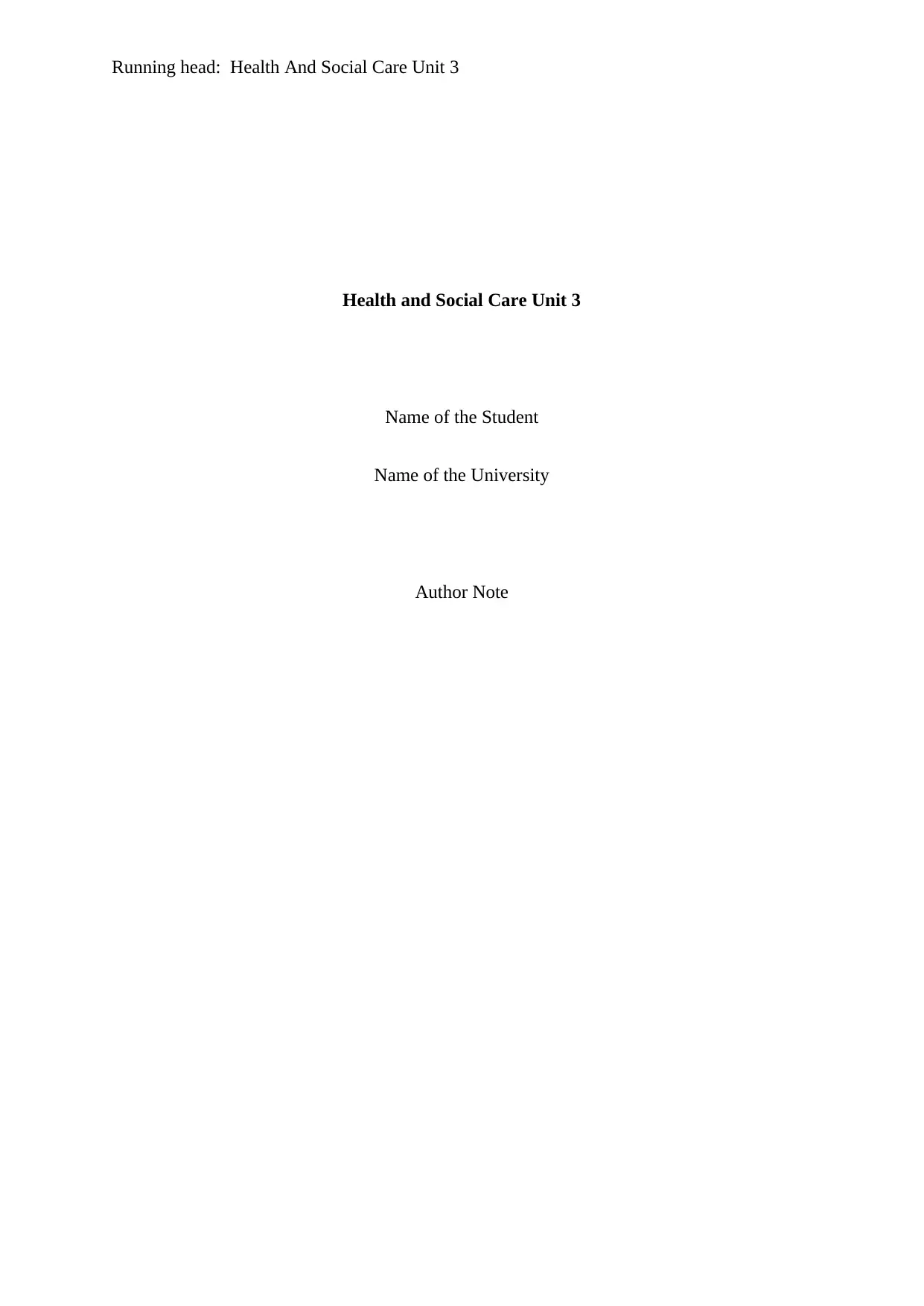
Running head: Health And Social Care Unit 3
Health and Social Care Unit 3
Name of the Student
Name of the University
Author Note
Health and Social Care Unit 3
Name of the Student
Name of the University
Author Note
Secure Best Marks with AI Grader
Need help grading? Try our AI Grader for instant feedback on your assignments.
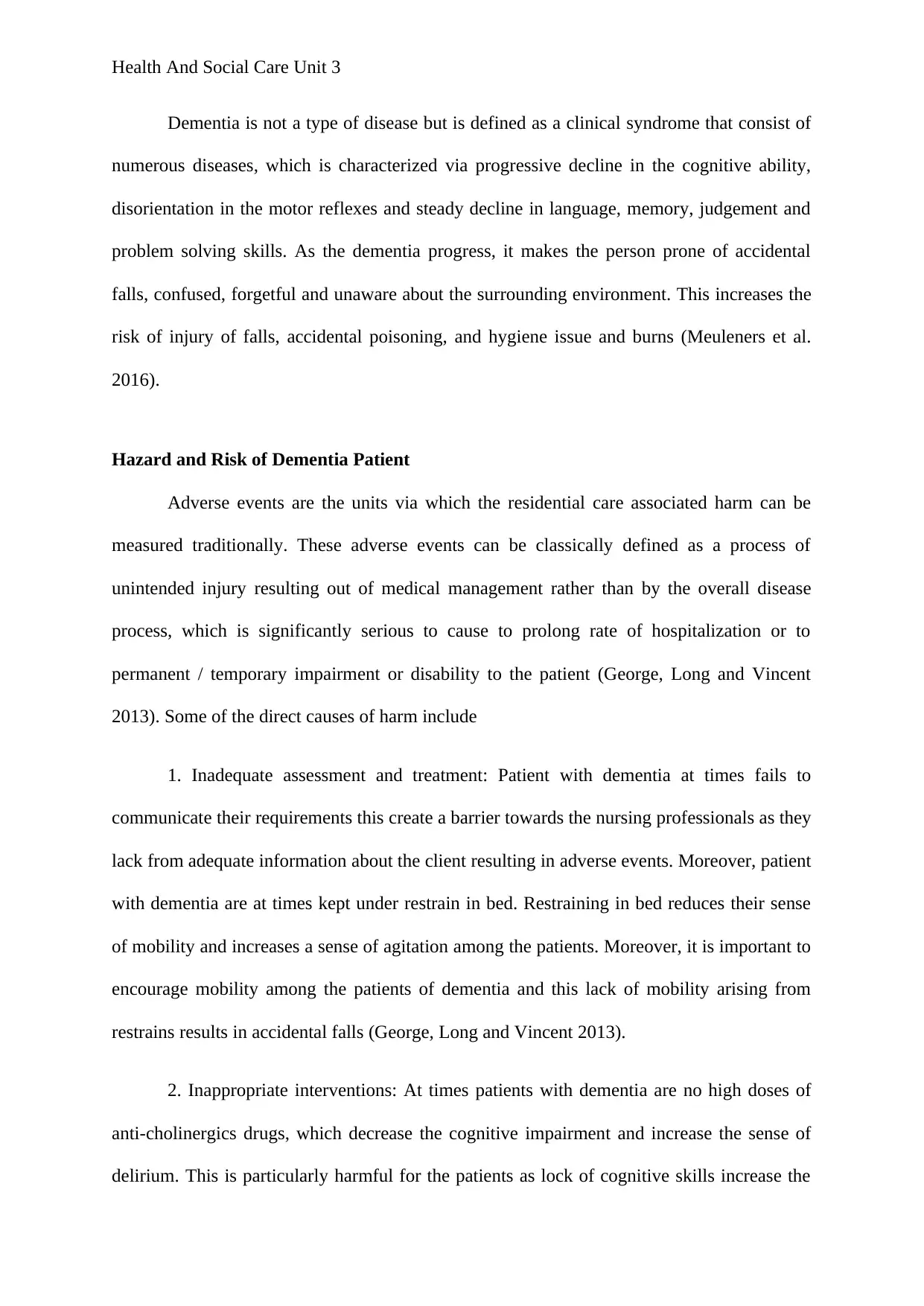
Health And Social Care Unit 3
Dementia is not a type of disease but is defined as a clinical syndrome that consist of
numerous diseases, which is characterized via progressive decline in the cognitive ability,
disorientation in the motor reflexes and steady decline in language, memory, judgement and
problem solving skills. As the dementia progress, it makes the person prone of accidental
falls, confused, forgetful and unaware about the surrounding environment. This increases the
risk of injury of falls, accidental poisoning, and hygiene issue and burns (Meuleners et al.
2016).
Hazard and Risk of Dementia Patient
Adverse events are the units via which the residential care associated harm can be
measured traditionally. These adverse events can be classically defined as a process of
unintended injury resulting out of medical management rather than by the overall disease
process, which is significantly serious to cause to prolong rate of hospitalization or to
permanent / temporary impairment or disability to the patient (George, Long and Vincent
2013). Some of the direct causes of harm include
1. Inadequate assessment and treatment: Patient with dementia at times fails to
communicate their requirements this create a barrier towards the nursing professionals as they
lack from adequate information about the client resulting in adverse events. Moreover, patient
with dementia are at times kept under restrain in bed. Restraining in bed reduces their sense
of mobility and increases a sense of agitation among the patients. Moreover, it is important to
encourage mobility among the patients of dementia and this lack of mobility arising from
restrains results in accidental falls (George, Long and Vincent 2013).
2. Inappropriate interventions: At times patients with dementia are no high doses of
anti-cholinergics drugs, which decrease the cognitive impairment and increase the sense of
delirium. This is particularly harmful for the patients as lock of cognitive skills increase the
Dementia is not a type of disease but is defined as a clinical syndrome that consist of
numerous diseases, which is characterized via progressive decline in the cognitive ability,
disorientation in the motor reflexes and steady decline in language, memory, judgement and
problem solving skills. As the dementia progress, it makes the person prone of accidental
falls, confused, forgetful and unaware about the surrounding environment. This increases the
risk of injury of falls, accidental poisoning, and hygiene issue and burns (Meuleners et al.
2016).
Hazard and Risk of Dementia Patient
Adverse events are the units via which the residential care associated harm can be
measured traditionally. These adverse events can be classically defined as a process of
unintended injury resulting out of medical management rather than by the overall disease
process, which is significantly serious to cause to prolong rate of hospitalization or to
permanent / temporary impairment or disability to the patient (George, Long and Vincent
2013). Some of the direct causes of harm include
1. Inadequate assessment and treatment: Patient with dementia at times fails to
communicate their requirements this create a barrier towards the nursing professionals as they
lack from adequate information about the client resulting in adverse events. Moreover, patient
with dementia are at times kept under restrain in bed. Restraining in bed reduces their sense
of mobility and increases a sense of agitation among the patients. Moreover, it is important to
encourage mobility among the patients of dementia and this lack of mobility arising from
restrains results in accidental falls (George, Long and Vincent 2013).
2. Inappropriate interventions: At times patients with dementia are no high doses of
anti-cholinergics drugs, which decrease the cognitive impairment and increase the sense of
delirium. This is particularly harmful for the patients as lock of cognitive skills increase the
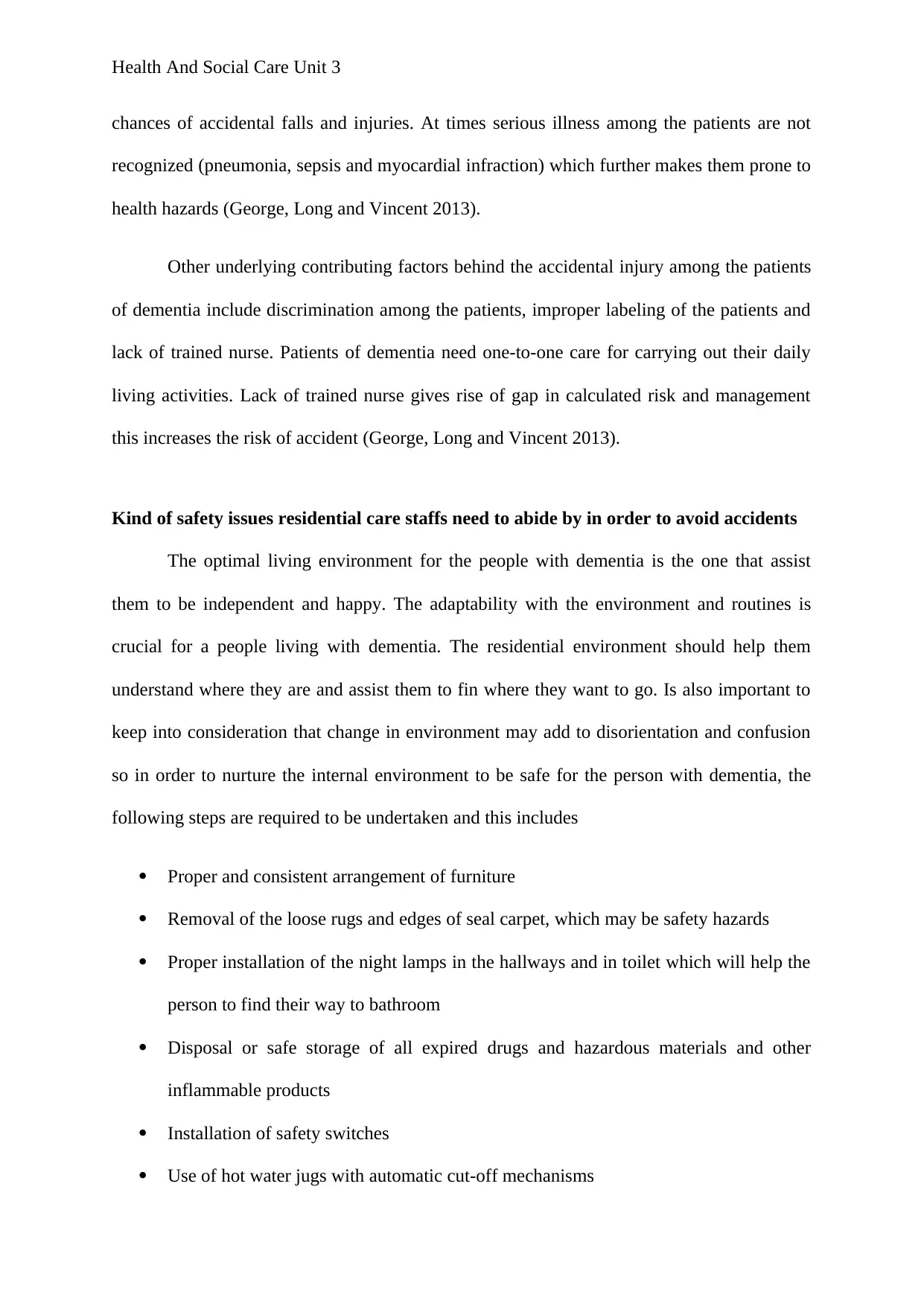
Health And Social Care Unit 3
chances of accidental falls and injuries. At times serious illness among the patients are not
recognized (pneumonia, sepsis and myocardial infraction) which further makes them prone to
health hazards (George, Long and Vincent 2013).
Other underlying contributing factors behind the accidental injury among the patients
of dementia include discrimination among the patients, improper labeling of the patients and
lack of trained nurse. Patients of dementia need one-to-one care for carrying out their daily
living activities. Lack of trained nurse gives rise of gap in calculated risk and management
this increases the risk of accident (George, Long and Vincent 2013).
Kind of safety issues residential care staffs need to abide by in order to avoid accidents
The optimal living environment for the people with dementia is the one that assist
them to be independent and happy. The adaptability with the environment and routines is
crucial for a people living with dementia. The residential environment should help them
understand where they are and assist them to fin where they want to go. Is also important to
keep into consideration that change in environment may add to disorientation and confusion
so in order to nurture the internal environment to be safe for the person with dementia, the
following steps are required to be undertaken and this includes
Proper and consistent arrangement of furniture
Removal of the loose rugs and edges of seal carpet, which may be safety hazards
Proper installation of the night lamps in the hallways and in toilet which will help the
person to find their way to bathroom
Disposal or safe storage of all expired drugs and hazardous materials and other
inflammable products
Installation of safety switches
Use of hot water jugs with automatic cut-off mechanisms
chances of accidental falls and injuries. At times serious illness among the patients are not
recognized (pneumonia, sepsis and myocardial infraction) which further makes them prone to
health hazards (George, Long and Vincent 2013).
Other underlying contributing factors behind the accidental injury among the patients
of dementia include discrimination among the patients, improper labeling of the patients and
lack of trained nurse. Patients of dementia need one-to-one care for carrying out their daily
living activities. Lack of trained nurse gives rise of gap in calculated risk and management
this increases the risk of accident (George, Long and Vincent 2013).
Kind of safety issues residential care staffs need to abide by in order to avoid accidents
The optimal living environment for the people with dementia is the one that assist
them to be independent and happy. The adaptability with the environment and routines is
crucial for a people living with dementia. The residential environment should help them
understand where they are and assist them to fin where they want to go. Is also important to
keep into consideration that change in environment may add to disorientation and confusion
so in order to nurture the internal environment to be safe for the person with dementia, the
following steps are required to be undertaken and this includes
Proper and consistent arrangement of furniture
Removal of the loose rugs and edges of seal carpet, which may be safety hazards
Proper installation of the night lamps in the hallways and in toilet which will help the
person to find their way to bathroom
Disposal or safe storage of all expired drugs and hazardous materials and other
inflammable products
Installation of safety switches
Use of hot water jugs with automatic cut-off mechanisms
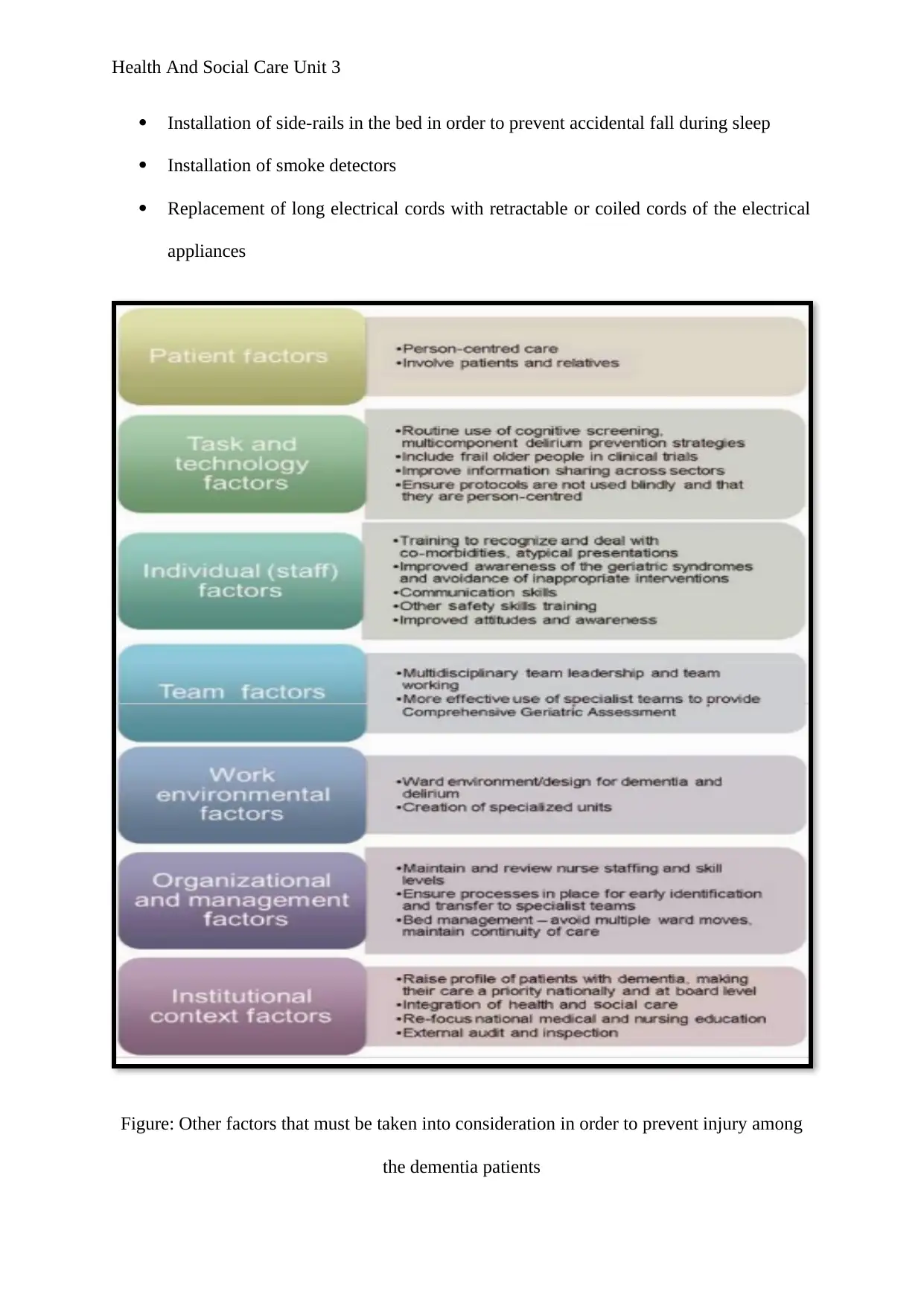
Health And Social Care Unit 3
Installation of side-rails in the bed in order to prevent accidental fall during sleep
Installation of smoke detectors
Replacement of long electrical cords with retractable or coiled cords of the electrical
appliances
Figure: Other factors that must be taken into consideration in order to prevent injury among
the dementia patients
Installation of side-rails in the bed in order to prevent accidental fall during sleep
Installation of smoke detectors
Replacement of long electrical cords with retractable or coiled cords of the electrical
appliances
Figure: Other factors that must be taken into consideration in order to prevent injury among
the dementia patients
Secure Best Marks with AI Grader
Need help grading? Try our AI Grader for instant feedback on your assignments.
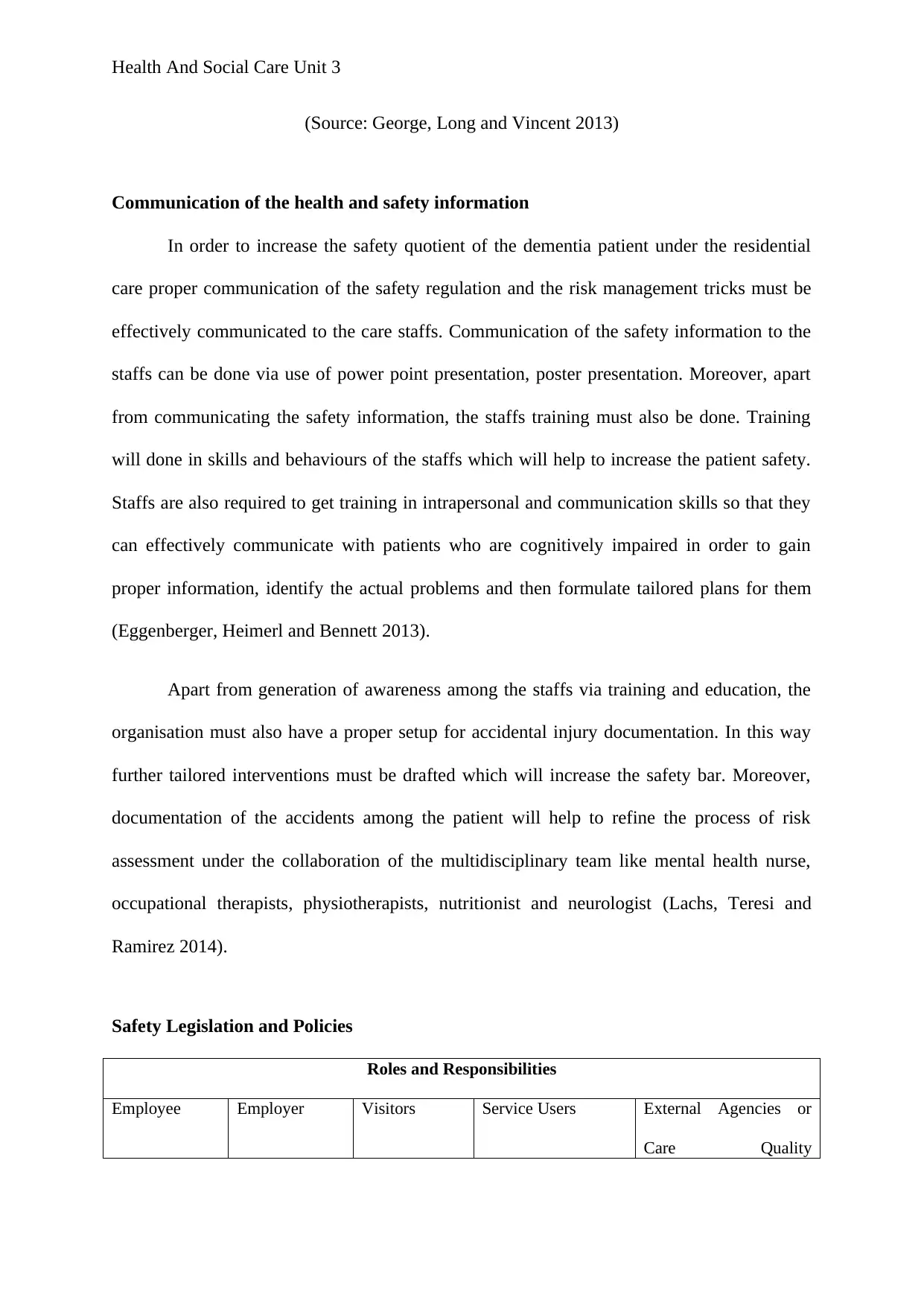
Health And Social Care Unit 3
(Source: George, Long and Vincent 2013)
Communication of the health and safety information
In order to increase the safety quotient of the dementia patient under the residential
care proper communication of the safety regulation and the risk management tricks must be
effectively communicated to the care staffs. Communication of the safety information to the
staffs can be done via use of power point presentation, poster presentation. Moreover, apart
from communicating the safety information, the staffs training must also be done. Training
will done in skills and behaviours of the staffs which will help to increase the patient safety.
Staffs are also required to get training in intrapersonal and communication skills so that they
can effectively communicate with patients who are cognitively impaired in order to gain
proper information, identify the actual problems and then formulate tailored plans for them
(Eggenberger, Heimerl and Bennett 2013).
Apart from generation of awareness among the staffs via training and education, the
organisation must also have a proper setup for accidental injury documentation. In this way
further tailored interventions must be drafted which will increase the safety bar. Moreover,
documentation of the accidents among the patient will help to refine the process of risk
assessment under the collaboration of the multidisciplinary team like mental health nurse,
occupational therapists, physiotherapists, nutritionist and neurologist (Lachs, Teresi and
Ramirez 2014).
Safety Legislation and Policies
Roles and Responsibilities
Employee Employer Visitors Service Users External Agencies or
Care Quality
(Source: George, Long and Vincent 2013)
Communication of the health and safety information
In order to increase the safety quotient of the dementia patient under the residential
care proper communication of the safety regulation and the risk management tricks must be
effectively communicated to the care staffs. Communication of the safety information to the
staffs can be done via use of power point presentation, poster presentation. Moreover, apart
from communicating the safety information, the staffs training must also be done. Training
will done in skills and behaviours of the staffs which will help to increase the patient safety.
Staffs are also required to get training in intrapersonal and communication skills so that they
can effectively communicate with patients who are cognitively impaired in order to gain
proper information, identify the actual problems and then formulate tailored plans for them
(Eggenberger, Heimerl and Bennett 2013).
Apart from generation of awareness among the staffs via training and education, the
organisation must also have a proper setup for accidental injury documentation. In this way
further tailored interventions must be drafted which will increase the safety bar. Moreover,
documentation of the accidents among the patient will help to refine the process of risk
assessment under the collaboration of the multidisciplinary team like mental health nurse,
occupational therapists, physiotherapists, nutritionist and neurologist (Lachs, Teresi and
Ramirez 2014).
Safety Legislation and Policies
Roles and Responsibilities
Employee Employer Visitors Service Users External Agencies or
Care Quality
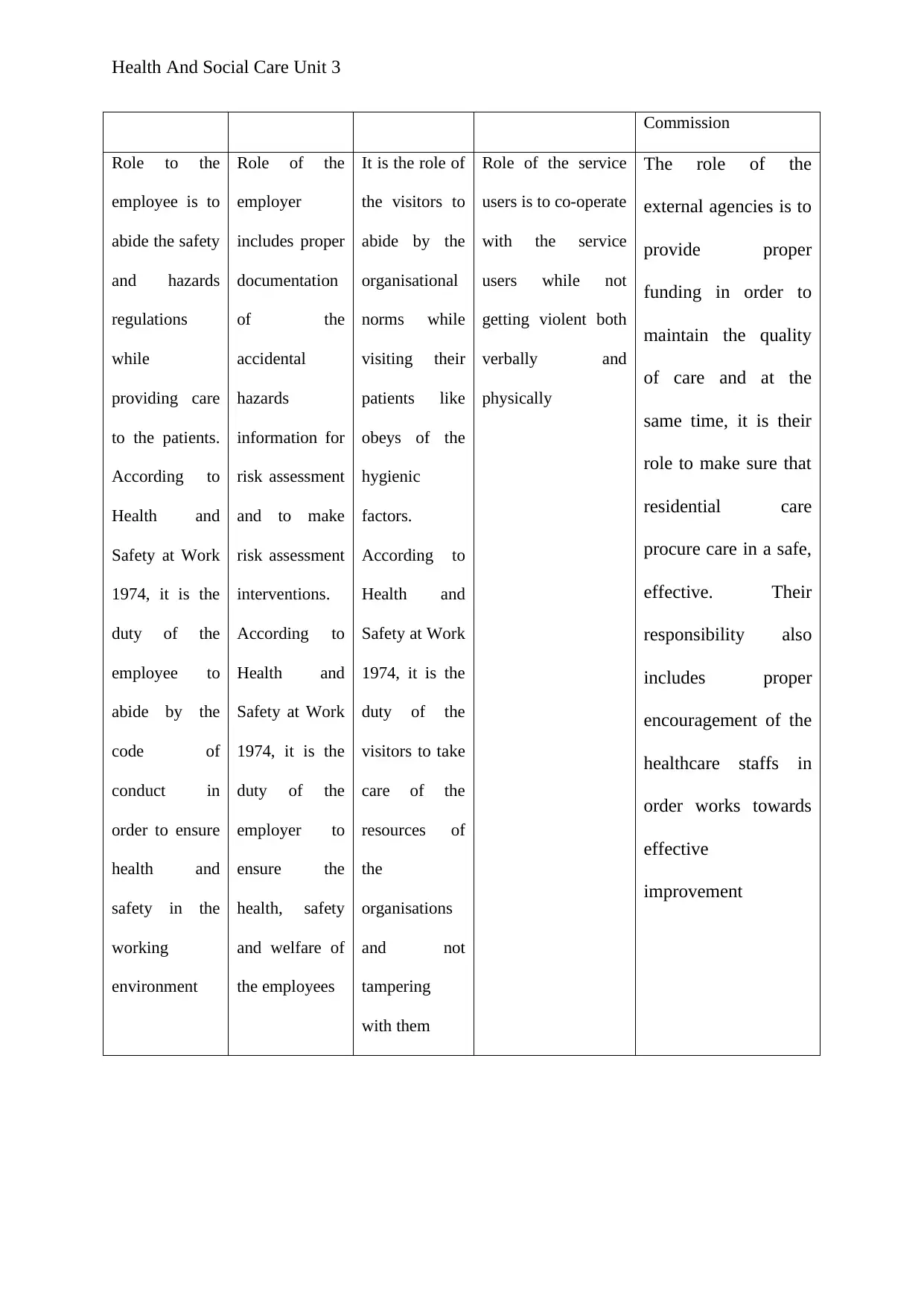
Health And Social Care Unit 3
Commission
Role to the
employee is to
abide the safety
and hazards
regulations
while
providing care
to the patients.
According to
Health and
Safety at Work
1974, it is the
duty of the
employee to
abide by the
code of
conduct in
order to ensure
health and
safety in the
working
environment
Role of the
employer
includes proper
documentation
of the
accidental
hazards
information for
risk assessment
and to make
risk assessment
interventions.
According to
Health and
Safety at Work
1974, it is the
duty of the
employer to
ensure the
health, safety
and welfare of
the employees
It is the role of
the visitors to
abide by the
organisational
norms while
visiting their
patients like
obeys of the
hygienic
factors.
According to
Health and
Safety at Work
1974, it is the
duty of the
visitors to take
care of the
resources of
the
organisations
and not
tampering
with them
Role of the service
users is to co-operate
with the service
users while not
getting violent both
verbally and
physically
The role of the
external agencies is to
provide proper
funding in order to
maintain the quality
of care and at the
same time, it is their
role to make sure that
residential care
procure care in a safe,
effective. Their
responsibility also
includes proper
encouragement of the
healthcare staffs in
order works towards
effective
improvement
Commission
Role to the
employee is to
abide the safety
and hazards
regulations
while
providing care
to the patients.
According to
Health and
Safety at Work
1974, it is the
duty of the
employee to
abide by the
code of
conduct in
order to ensure
health and
safety in the
working
environment
Role of the
employer
includes proper
documentation
of the
accidental
hazards
information for
risk assessment
and to make
risk assessment
interventions.
According to
Health and
Safety at Work
1974, it is the
duty of the
employer to
ensure the
health, safety
and welfare of
the employees
It is the role of
the visitors to
abide by the
organisational
norms while
visiting their
patients like
obeys of the
hygienic
factors.
According to
Health and
Safety at Work
1974, it is the
duty of the
visitors to take
care of the
resources of
the
organisations
and not
tampering
with them
Role of the service
users is to co-operate
with the service
users while not
getting violent both
verbally and
physically
The role of the
external agencies is to
provide proper
funding in order to
maintain the quality
of care and at the
same time, it is their
role to make sure that
residential care
procure care in a safe,
effective. Their
responsibility also
includes proper
encouragement of the
healthcare staffs in
order works towards
effective
improvement
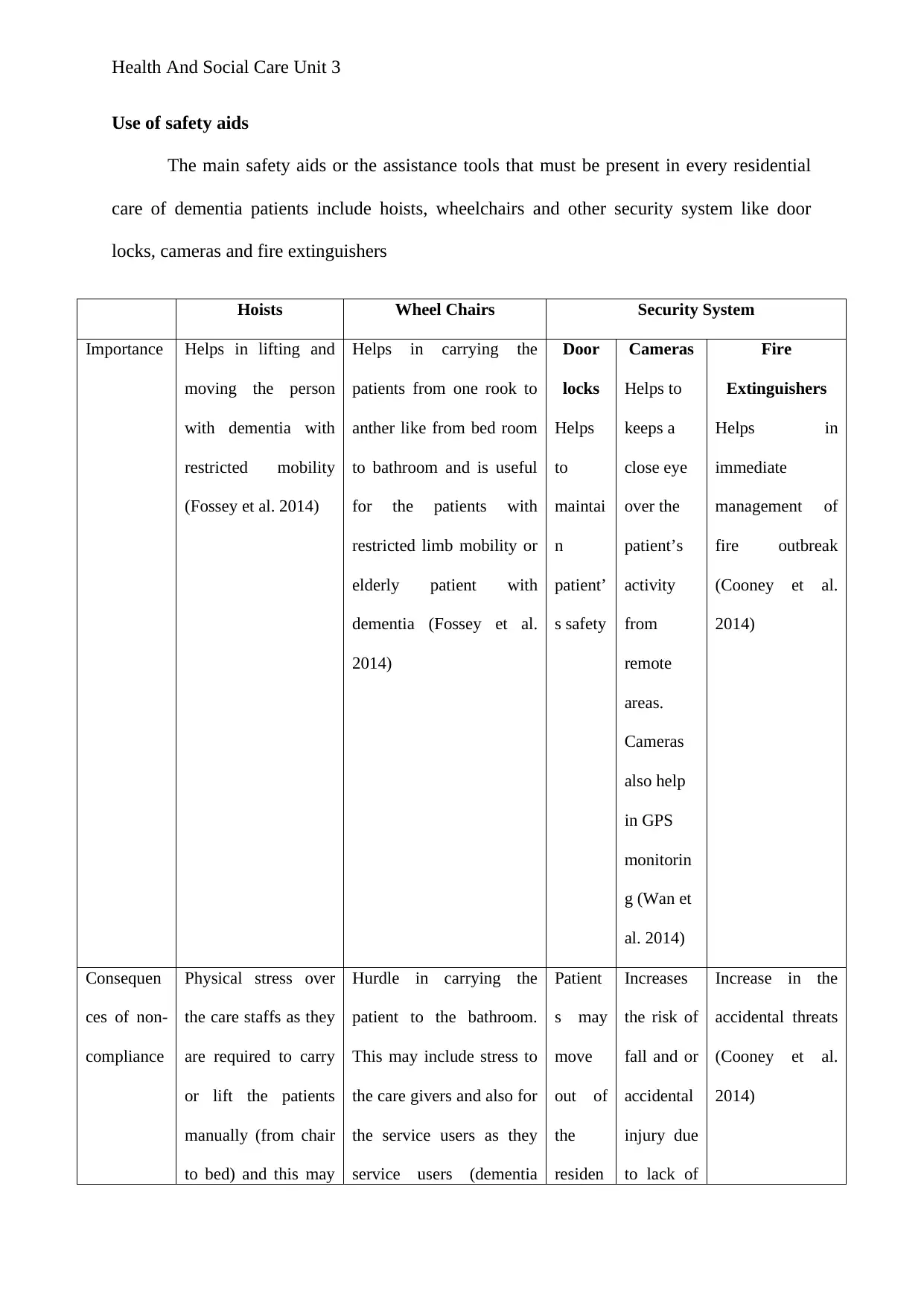
Health And Social Care Unit 3
Use of safety aids
The main safety aids or the assistance tools that must be present in every residential
care of dementia patients include hoists, wheelchairs and other security system like door
locks, cameras and fire extinguishers
Hoists Wheel Chairs Security System
Importance Helps in lifting and
moving the person
with dementia with
restricted mobility
(Fossey et al. 2014)
Helps in carrying the
patients from one rook to
anther like from bed room
to bathroom and is useful
for the patients with
restricted limb mobility or
elderly patient with
dementia (Fossey et al.
2014)
Door
locks
Helps
to
maintai
n
patient’
s safety
Cameras
Helps to
keeps a
close eye
over the
patient’s
activity
from
remote
areas.
Cameras
also help
in GPS
monitorin
g (Wan et
al. 2014)
Fire
Extinguishers
Helps in
immediate
management of
fire outbreak
(Cooney et al.
2014)
Consequen
ces of non-
compliance
Physical stress over
the care staffs as they
are required to carry
or lift the patients
manually (from chair
to bed) and this may
Hurdle in carrying the
patient to the bathroom.
This may include stress to
the care givers and also for
the service users as they
service users (dementia
Patient
s may
move
out of
the
residen
Increases
the risk of
fall and or
accidental
injury due
to lack of
Increase in the
accidental threats
(Cooney et al.
2014)
Use of safety aids
The main safety aids or the assistance tools that must be present in every residential
care of dementia patients include hoists, wheelchairs and other security system like door
locks, cameras and fire extinguishers
Hoists Wheel Chairs Security System
Importance Helps in lifting and
moving the person
with dementia with
restricted mobility
(Fossey et al. 2014)
Helps in carrying the
patients from one rook to
anther like from bed room
to bathroom and is useful
for the patients with
restricted limb mobility or
elderly patient with
dementia (Fossey et al.
2014)
Door
locks
Helps
to
maintai
n
patient’
s safety
Cameras
Helps to
keeps a
close eye
over the
patient’s
activity
from
remote
areas.
Cameras
also help
in GPS
monitorin
g (Wan et
al. 2014)
Fire
Extinguishers
Helps in
immediate
management of
fire outbreak
(Cooney et al.
2014)
Consequen
ces of non-
compliance
Physical stress over
the care staffs as they
are required to carry
or lift the patients
manually (from chair
to bed) and this may
Hurdle in carrying the
patient to the bathroom.
This may include stress to
the care givers and also for
the service users as they
service users (dementia
Patient
s may
move
out of
the
residen
Increases
the risk of
fall and or
accidental
injury due
to lack of
Increase in the
accidental threats
(Cooney et al.
2014)
Paraphrase This Document
Need a fresh take? Get an instant paraphrase of this document with our AI Paraphraser
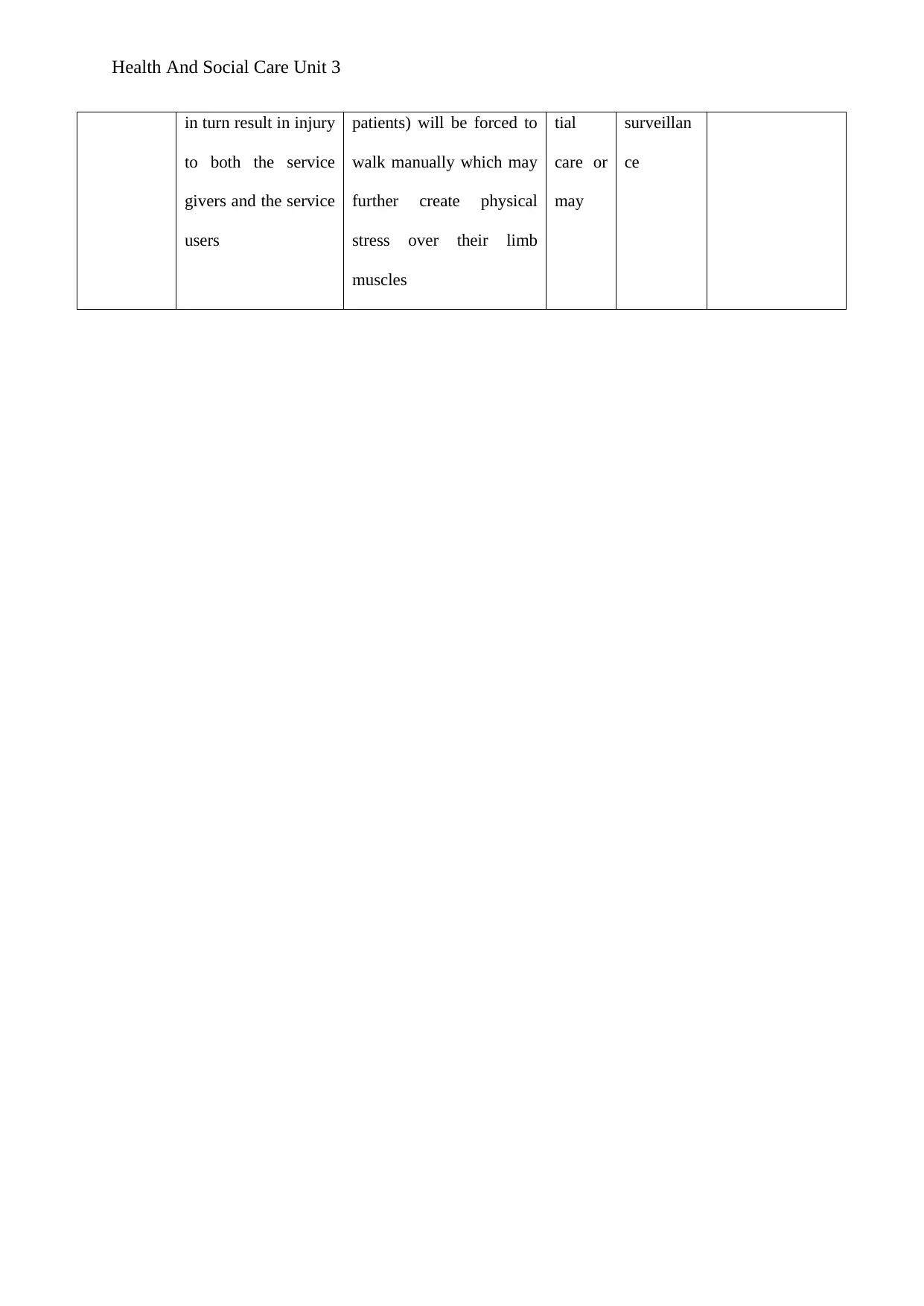
Health And Social Care Unit 3
in turn result in injury
to both the service
givers and the service
users
patients) will be forced to
walk manually which may
further create physical
stress over their limb
muscles
tial
care or
may
surveillan
ce
in turn result in injury
to both the service
givers and the service
users
patients) will be forced to
walk manually which may
further create physical
stress over their limb
muscles
tial
care or
may
surveillan
ce
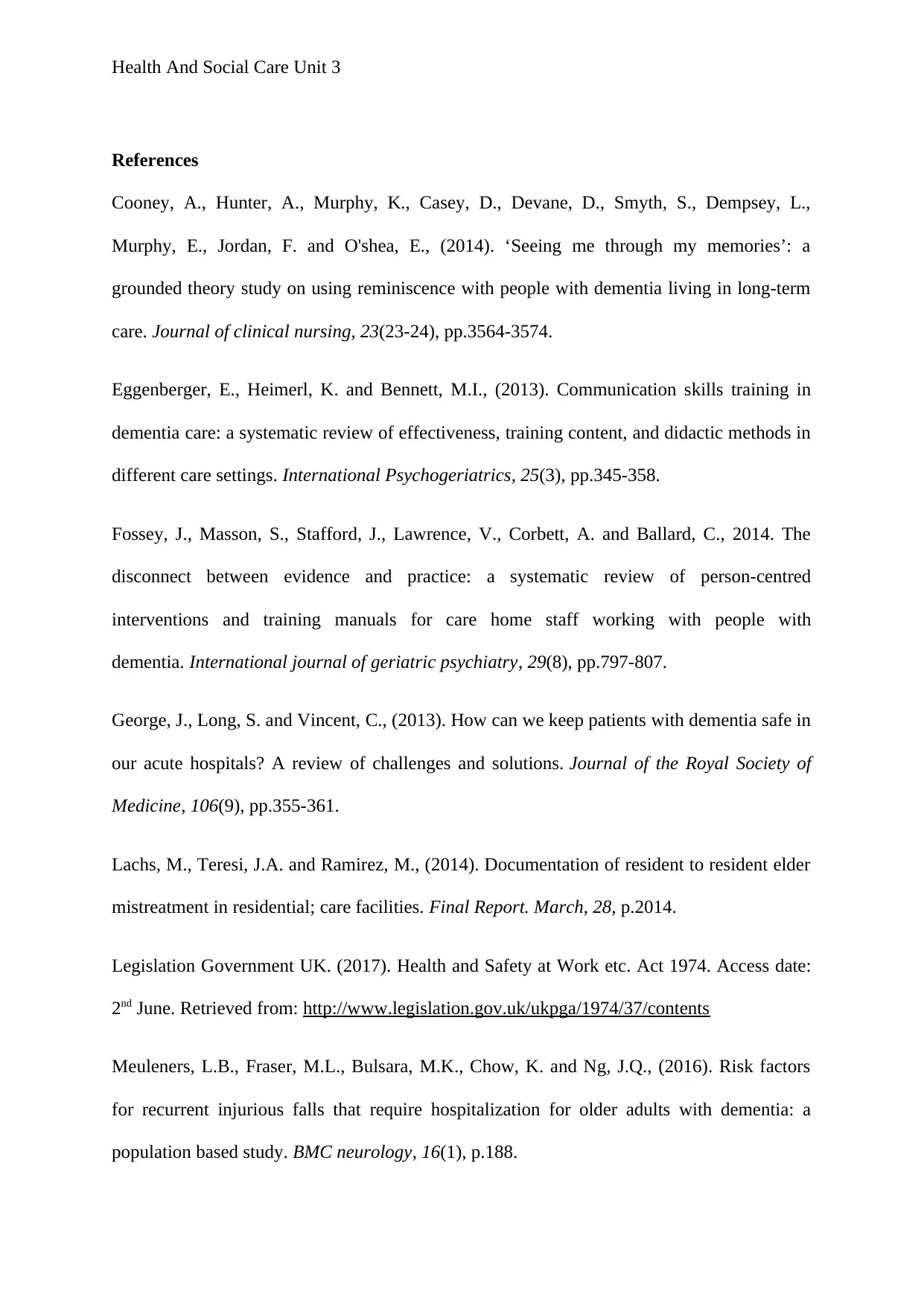
Health And Social Care Unit 3
References
Cooney, A., Hunter, A., Murphy, K., Casey, D., Devane, D., Smyth, S., Dempsey, L.,
Murphy, E., Jordan, F. and O'shea, E., (2014). ‘Seeing me through my memories’: a
grounded theory study on using reminiscence with people with dementia living in long‐term
care. Journal of clinical nursing, 23(23-24), pp.3564-3574.
Eggenberger, E., Heimerl, K. and Bennett, M.I., (2013). Communication skills training in
dementia care: a systematic review of effectiveness, training content, and didactic methods in
different care settings. International Psychogeriatrics, 25(3), pp.345-358.
Fossey, J., Masson, S., Stafford, J., Lawrence, V., Corbett, A. and Ballard, C., 2014. The
disconnect between evidence and practice: a systematic review of person‐centred
interventions and training manuals for care home staff working with people with
dementia. International journal of geriatric psychiatry, 29(8), pp.797-807.
George, J., Long, S. and Vincent, C., (2013). How can we keep patients with dementia safe in
our acute hospitals? A review of challenges and solutions. Journal of the Royal Society of
Medicine, 106(9), pp.355-361.
Lachs, M., Teresi, J.A. and Ramirez, M., (2014). Documentation of resident to resident elder
mistreatment in residential; care facilities. Final Report. March, 28, p.2014.
Legislation Government UK. (2017). Health and Safety at Work etc. Act 1974. Access date:
2nd June. Retrieved from: http://www.legislation.gov.uk/ukpga/1974/37/contents
Meuleners, L.B., Fraser, M.L., Bulsara, M.K., Chow, K. and Ng, J.Q., (2016). Risk factors
for recurrent injurious falls that require hospitalization for older adults with dementia: a
population based study. BMC neurology, 16(1), p.188.
References
Cooney, A., Hunter, A., Murphy, K., Casey, D., Devane, D., Smyth, S., Dempsey, L.,
Murphy, E., Jordan, F. and O'shea, E., (2014). ‘Seeing me through my memories’: a
grounded theory study on using reminiscence with people with dementia living in long‐term
care. Journal of clinical nursing, 23(23-24), pp.3564-3574.
Eggenberger, E., Heimerl, K. and Bennett, M.I., (2013). Communication skills training in
dementia care: a systematic review of effectiveness, training content, and didactic methods in
different care settings. International Psychogeriatrics, 25(3), pp.345-358.
Fossey, J., Masson, S., Stafford, J., Lawrence, V., Corbett, A. and Ballard, C., 2014. The
disconnect between evidence and practice: a systematic review of person‐centred
interventions and training manuals for care home staff working with people with
dementia. International journal of geriatric psychiatry, 29(8), pp.797-807.
George, J., Long, S. and Vincent, C., (2013). How can we keep patients with dementia safe in
our acute hospitals? A review of challenges and solutions. Journal of the Royal Society of
Medicine, 106(9), pp.355-361.
Lachs, M., Teresi, J.A. and Ramirez, M., (2014). Documentation of resident to resident elder
mistreatment in residential; care facilities. Final Report. March, 28, p.2014.
Legislation Government UK. (2017). Health and Safety at Work etc. Act 1974. Access date:
2nd June. Retrieved from: http://www.legislation.gov.uk/ukpga/1974/37/contents
Meuleners, L.B., Fraser, M.L., Bulsara, M.K., Chow, K. and Ng, J.Q., (2016). Risk factors
for recurrent injurious falls that require hospitalization for older adults with dementia: a
population based study. BMC neurology, 16(1), p.188.
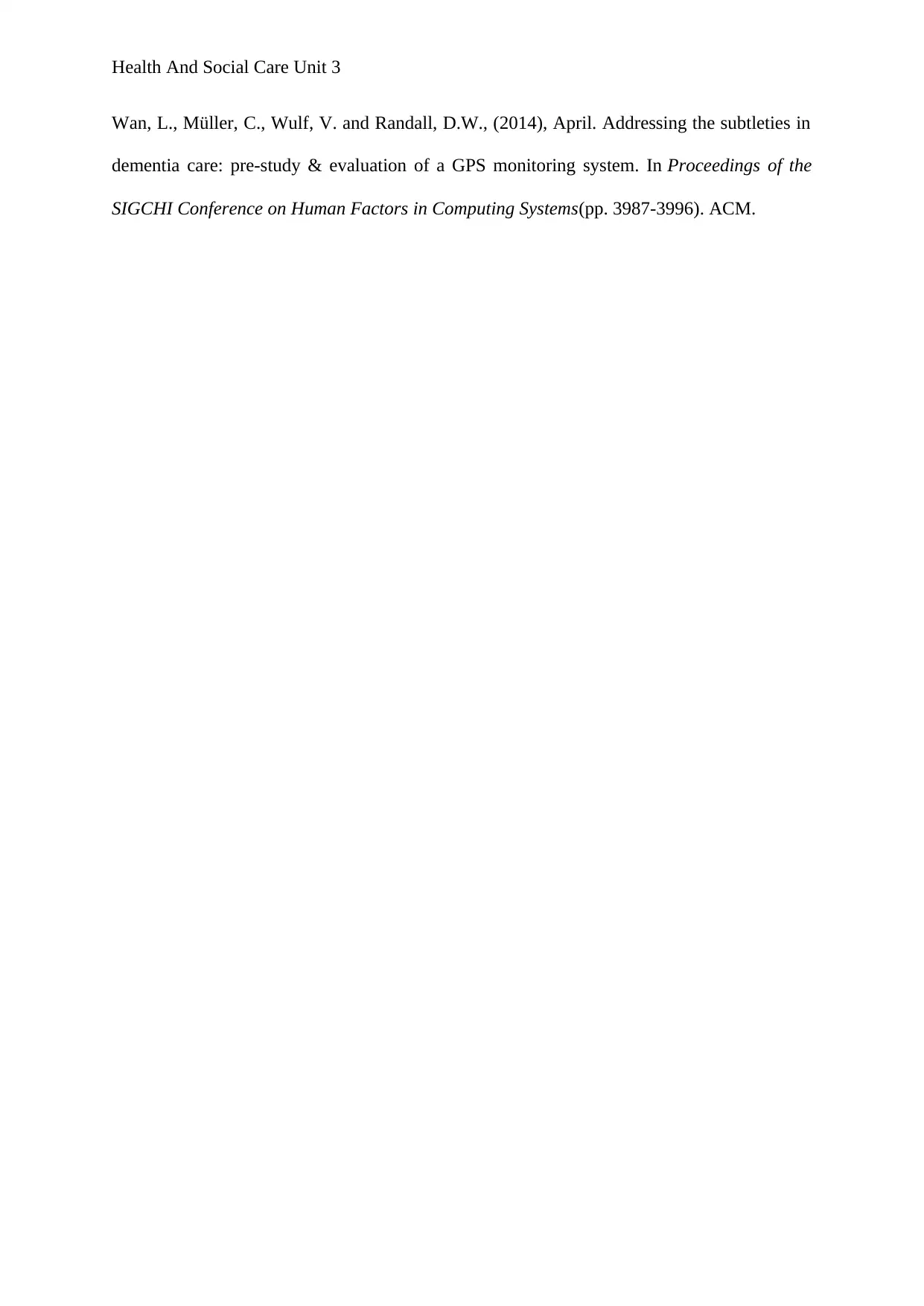
Health And Social Care Unit 3
Wan, L., Müller, C., Wulf, V. and Randall, D.W., (2014), April. Addressing the subtleties in
dementia care: pre-study & evaluation of a GPS monitoring system. In Proceedings of the
SIGCHI Conference on Human Factors in Computing Systems(pp. 3987-3996). ACM.
Wan, L., Müller, C., Wulf, V. and Randall, D.W., (2014), April. Addressing the subtleties in
dementia care: pre-study & evaluation of a GPS monitoring system. In Proceedings of the
SIGCHI Conference on Human Factors in Computing Systems(pp. 3987-3996). ACM.
1 out of 10
Related Documents
Your All-in-One AI-Powered Toolkit for Academic Success.
+13062052269
info@desklib.com
Available 24*7 on WhatsApp / Email
![[object Object]](/_next/static/media/star-bottom.7253800d.svg)
Unlock your academic potential
© 2024 | Zucol Services PVT LTD | All rights reserved.





